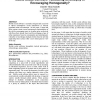Free Online Productivity Tools
i2Speak
i2Symbol
i2OCR
iTex2Img
iWeb2Print
iWeb2Shot
i2Type
iPdf2Split
iPdf2Merge
i2Bopomofo
i2Arabic
i2Style
i2Image
i2PDF
iLatex2Rtf
Sci2ools
PERVASIVE
2007
Springer
2007
Springer
Mobile Social Software: Facilitating Serendipity or Encouraging Homogeneity?
Mobile social software is currently designed and conceived to afford serendipitous social interactions in densely populated urban environments. In this paper, I argue that these systems create a more homogeneous representation of the city by encouraging users to socialize more exclusively with those they already know and by privileging a type of urban experience based on consumption and entertainment. I describe several design strategies drawn from the arts that might help these systems offer a more heterogeneous view of the city. Author Keywords Mobile social software, homophily, tactical intervention, critical design, interpretation ACM Classification Keywords H5.3. Information interfaces and presentation (e.g., HCI): Miscellaneous.
Applied Computing | Mobile Social Software | PERVASIVE 2007 | Populated Urban Environments | Social Software |
| Added | 27 Dec 2010 |
| Updated | 27 Dec 2010 |
| Type | Journal |
| Year | 2007 |
| Where | PERVASIVE |
| Authors | Jennifer Thom-Santelli |
Comments (0)

